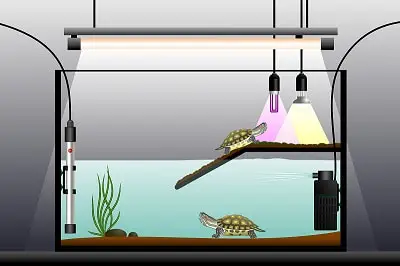Fish and turtle keepers have some things in common; their love for ornamental and exotic pets and the aquarium setups. Both parties would also want to keep the tank elegant to use it for aesthetic reasons. Therefore, the main issue is whether you can keep turtles and fish together.
You can keep fish and turtles in the same aquarium by paying close attention to certain critical factors. You need to consider their size, species, available space, filtration system, and prevailing conditions. It is vital to make the tank favorable for both animals.
This article is perfect for you if you are concerned about your pet’s safety but still want it to have a companion. Read on as we tell you which fish and turtle species can live together and the part you need to play to make it successful.

What To Consider When Keeping Fish and Turtles in the Same Tank
Keeping more than one animal in the same tank isn’t a walk in the park, and neither is it when the two are of different species. You have to put several measures in place to ensure that they are both safe and cohabit amicably.
Species
The most important factor to consider is whether the species are compatible as it directly connects to the safety of both animals. You can look at the respective sizes, diet, habitat requirements, and their ability to live well with each other. You aim to find turtles and fish close matched to avoid the inconvenience of dealing with extreme animals.
First, most turtles indulge in vegetation and prey, which puts your fish at great risk of turning into meals. Therefore, it is advisable to bring fish into the tank when your turtle is mature enough to only feed on plants. Alternatively, you can go for fish that are bigger than your turtle because it will significantly reduce the chances of attacks by the turtles.
Aquarium Size
Another important factor to consider is the available space. Most animals are territorial, meaning that they consider others as threats when they invade their space. The goal is to give them all enough space to roam and play and not get into each other’s way all the time. You will increase the likelihood of aggressive tendencies and stress, which can turn out fatal if you cramp them in a small enclosure.
Besides, a small tank will accumulate waste and dirt faster; hence, you will need a stronger filter to clean it out. Moreover, the filters will be overworked, leading to bacterial accumulation. The water should be as deep as twice the turtle’s length and also accommodate the fish. Consider ten gallons for every shell inch and the same volume for every fish inch at maturity.
Tank Conditions
With two different species in the same tank, it is vital to make their home conducive to favor both of them. First, consider the water quality, prevailing pH, temperature levels. It takes us back to species compatibility because it will be easier to cater to them when they thrive in similar conditions. If not, one will get stressed or die due to extreme cases.
Most turtle species live well under temperatures ranging from 70-800 degrees. However, these levels may be too much for some freshwater fish. Secondly, looking at the water quality, turtles excrete more than fish and are more hardy and able to adapt to different environments. When you pick a fish species, it is critical to choose the easiest species to adjust to such environments.
You also need a filtration system that will deal with the excrements from more pets. Canisters are the most effective because they are more potent to eliminate all the waste. They also filter the water in three or more stages to make your aquarium water crystal clear. Without it, the water will accumulate toxins that are fatal for both fish and turtles.
Read more: Best Turtle Tanks
What Fish Species Can Live With Turtles?
Your turtle may be the most easy-going pet ever, but you will be putting its life at risk if you introduce a deadly and demanding fish. You need to select the best species that will be compatible with your turtle and live amicably in the same habitat. Several fish species can share a home with less hostile turtles without attacks or aggressive tendencies.
The Pictus Catfish is fast and can grow to almost the size of a mature turtle, making it difficult for turtles to attack them. Similarly, the Koi fish are ideal when you need a companion for your turtle. They are strong, fast, and grow bigger with time, making it difficult for turtles to prey on them. Additionally, these fish come in various colors to spruce up your aquarium. The Suckermouth Catfish and Rosy Barbs are among the large fish turtles that find tasking to approach. Lastly, small, fast, and agile fish like the Neon Tetra, Zebrafish, and Guppies can live amicably with turtles.
Researchers discourage keeping goldfish together with turtles; however, certain breeds can cohabit because they have innate abilities to survive in such an environment. On the other hand, Betta fish make the worst companions because the turtles are omnivorous while the fish are smaller and slower. Therefore, the turtles can easily turn them into a tasty meal.
Unfortunately, some ferocious fish like the Piranha, Oscars, Lobsters, Catfish, and Electric Eel can injure, maim, kill, or eat the turtles. Ultimately, you should always ensure that the reptile is well-fed and on a full stomach for your fish and turtle to coexist. This way, they won’t get too hungry to turn to their mates for food. Also, avoid giving the turtles feeder fish, increasing their appetite for the protein-filled Pisces.
Ideally, you can first conduct a compatibility test to see how the turtle behaves towards the fish. If the reception is positive, you are safe to keep the fish in the tank, but, otherwise, keep them separately if you suspect that your turtle will end up getting hurt in the process. The good news is that you can condition the pet not to hunt fish but to see it as its counterparts, especially if you start with them as hatchlings.
What Turtle Species Can Live With Fish?
Many turtle owners forget that their pet turtle’s species is also a chief factor to consider when introducing fish in the aquarium. Not all turtles will welcome the idea of another animal invading their territory, while others will attack and feed on the fish.
The Red-Eared, Painted, and Pink Bellied turtles are the most likely species to attack tiny fish. They are great hunters that won’t hesitate to devour any fish you add to the tank unless the fish is bigger. The juveniles are more notorious for feeding on fish, but the adults are more inclined to plants. On the other hand, other species like the Musk and Mud turtles seem uninterested in attacking, and it helps that they are poor hunters. They are only adept at ambushing their prey while hiding in the mud on the ocean floor, but since the aquarium is a different setup, they will not practice their unique skill on your fish.
Placing fish in the same aquarium as juvenile turtles is too risky. Regardless of the species, young turtles love their meals fleshy since it provides proteins necessary for bodybuilding. Hence, they won’t hesitate to attack unless the fish are bigger. The best way to go is to wait till maturity when they indulge in more vegetables and will generally be uninterested in fleshy meals. You also need to be wary if your turtle was previously on a fish diet because it will view the addition as food and make a meal out of it.
You can put various steps to ensure that your fish is safe while living with the turtle. First, feed your turtle before the initial introduction because a well-fed pet will less likely feast on its new companion. Secondly, slowly introduce the fish to their new environment making them more comfortable in the prevailing conditions. Next, monitor how they interact with each other and act accordingly. You can let them be if the two live amicably and separate them if you see any confrontations or signs of aggression from either party.
Wrap Up
Deciding to put your fish and turtles in the same tank is a bold yet risky step. It is critical to be certain about it and place the necessary precautions; or else, you will be sacrificing one of them. Ideally, you can select fast-moving fish species that can easily evade turtle attacks if they fall prey. You can also select the ones that grow bigger than the turtles because it will be an uphill task to hunt them down.
Alternatively, it is best to select docile fish and place them together with compatible turtle species. You can also set up hiding spots for the fish to retreat when they feel frightened or need privacy. Always watch out for any form of aggression and be ready to evacuate your fish if it turns violent. The bottom line is, both your pets should be comfortable, and none should turn on the other for food; eventually, you will successfully keep both species.








